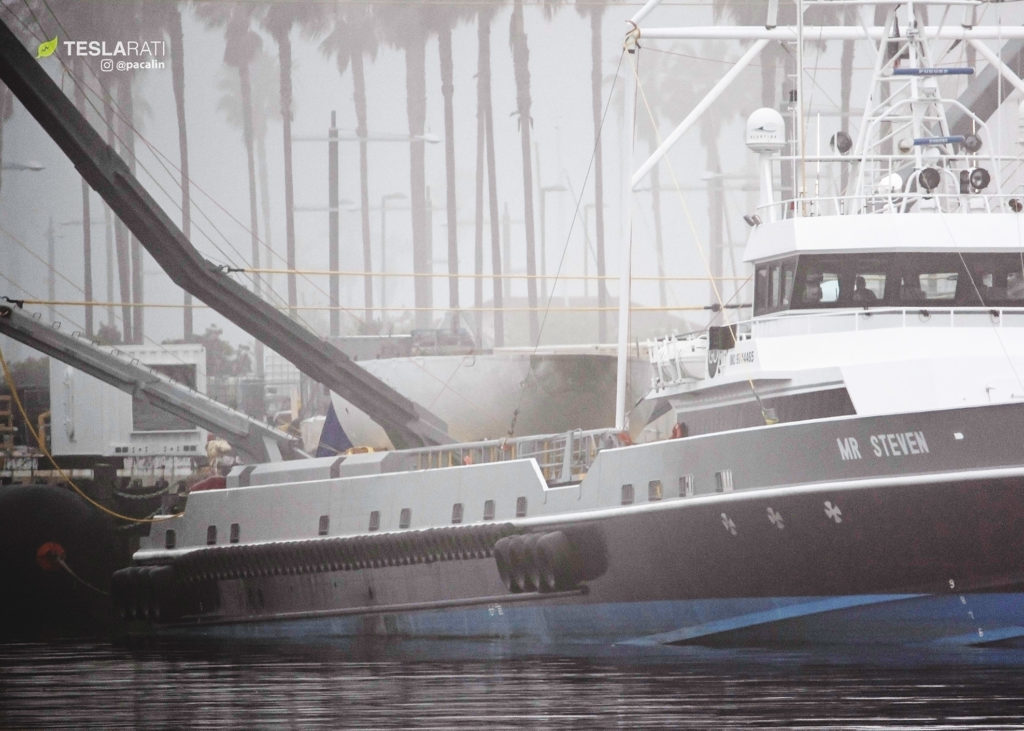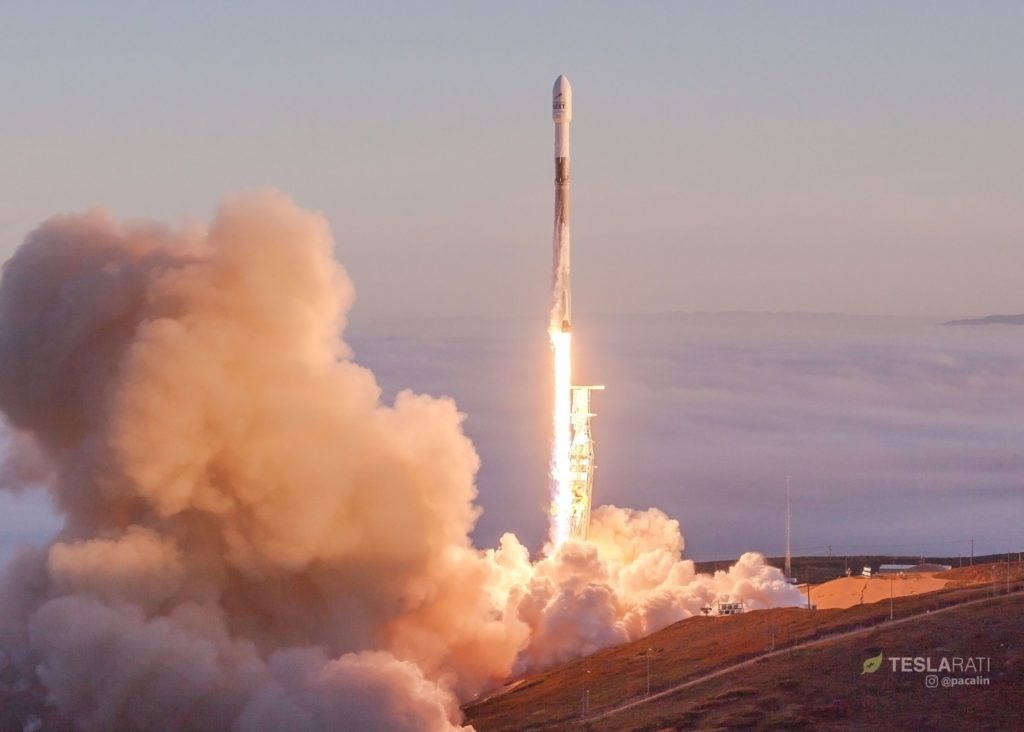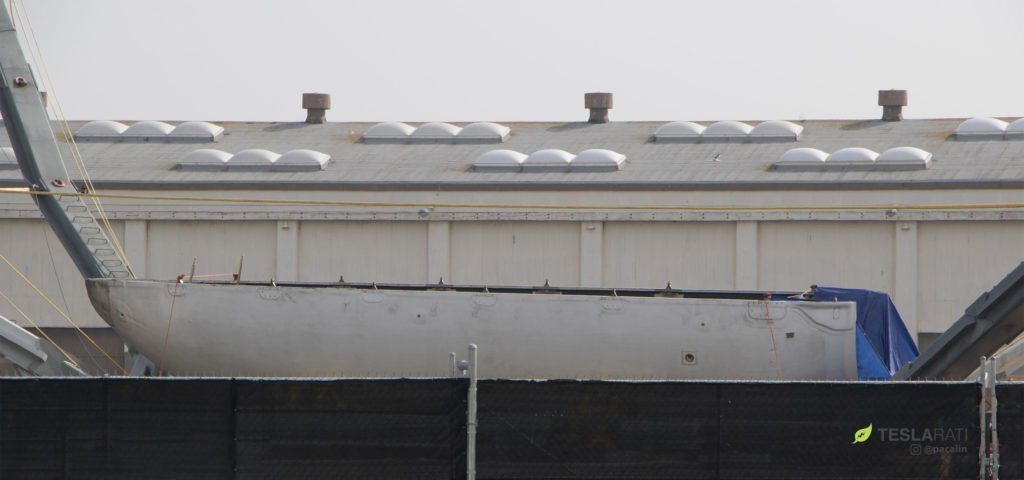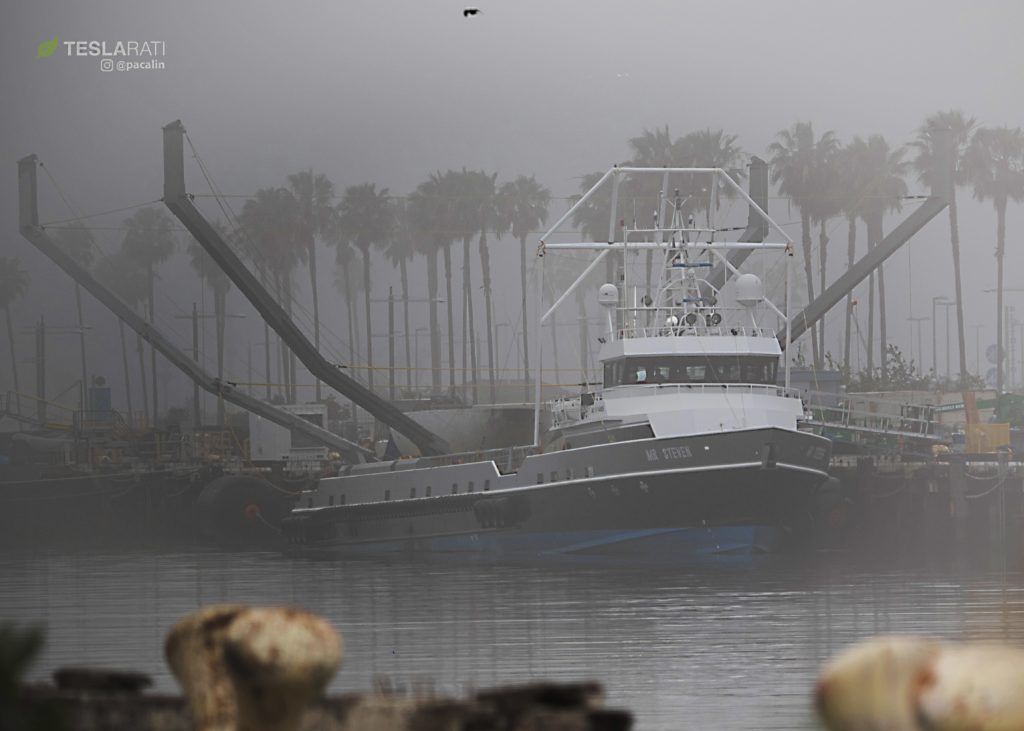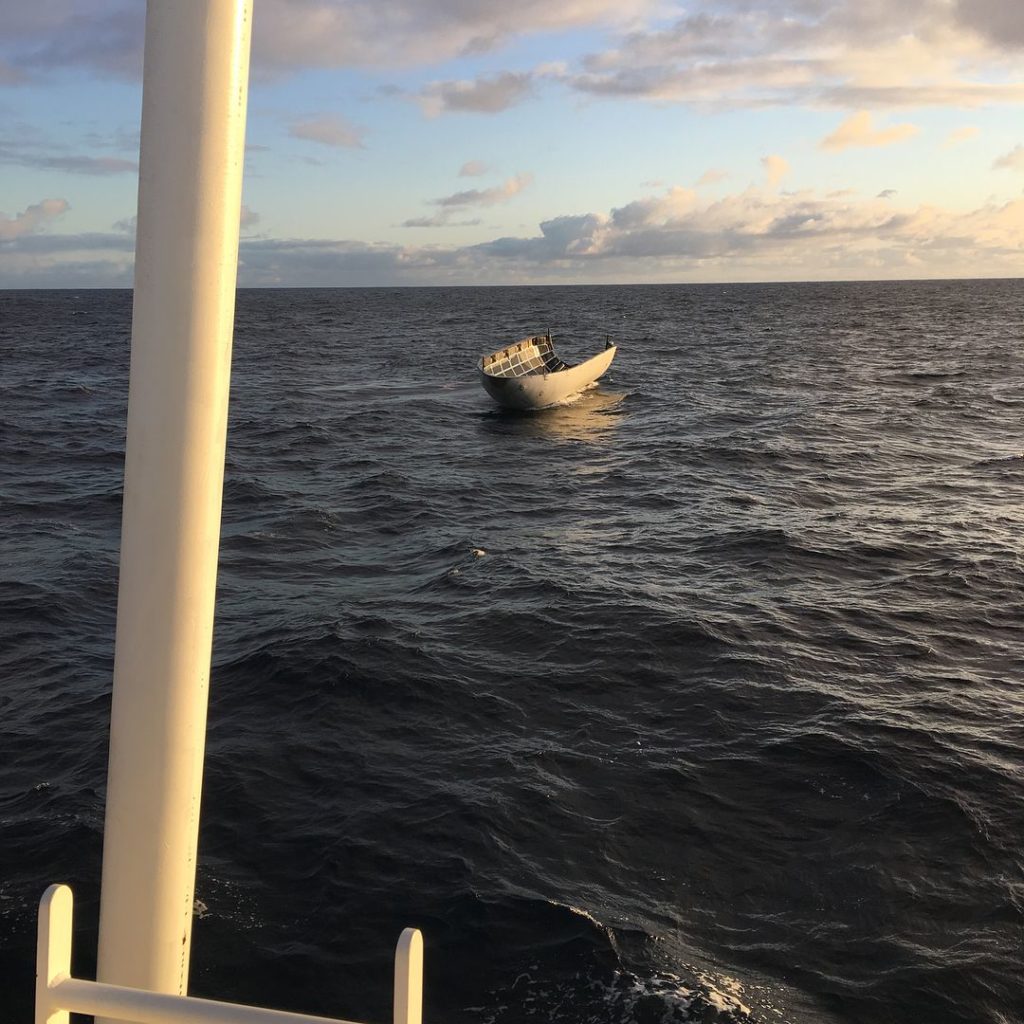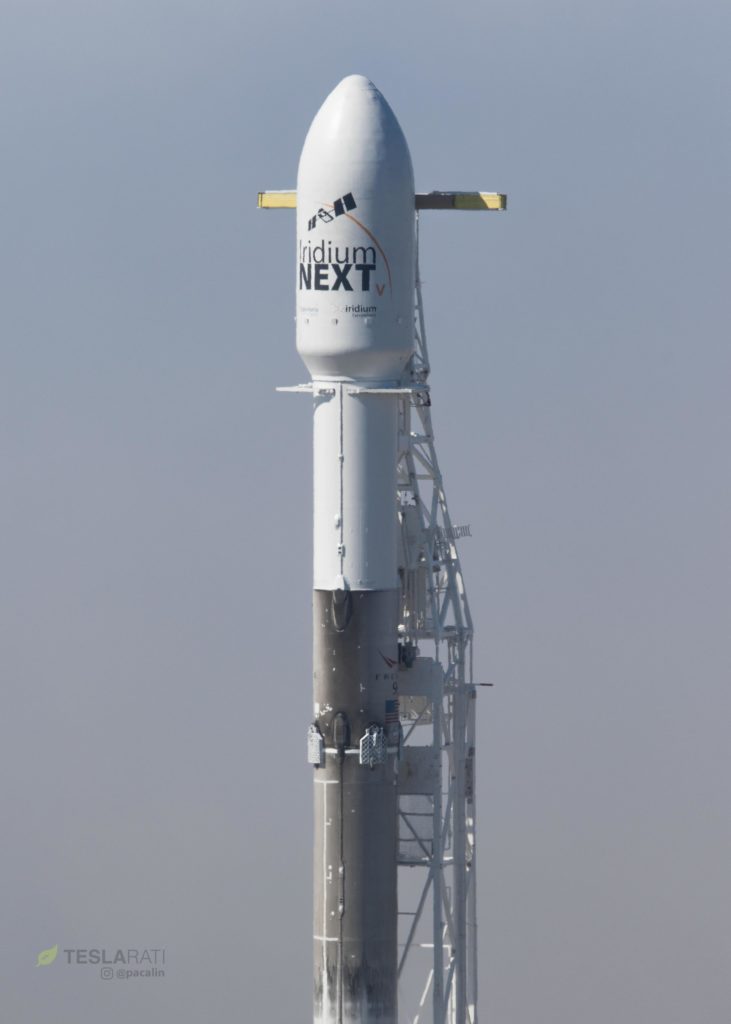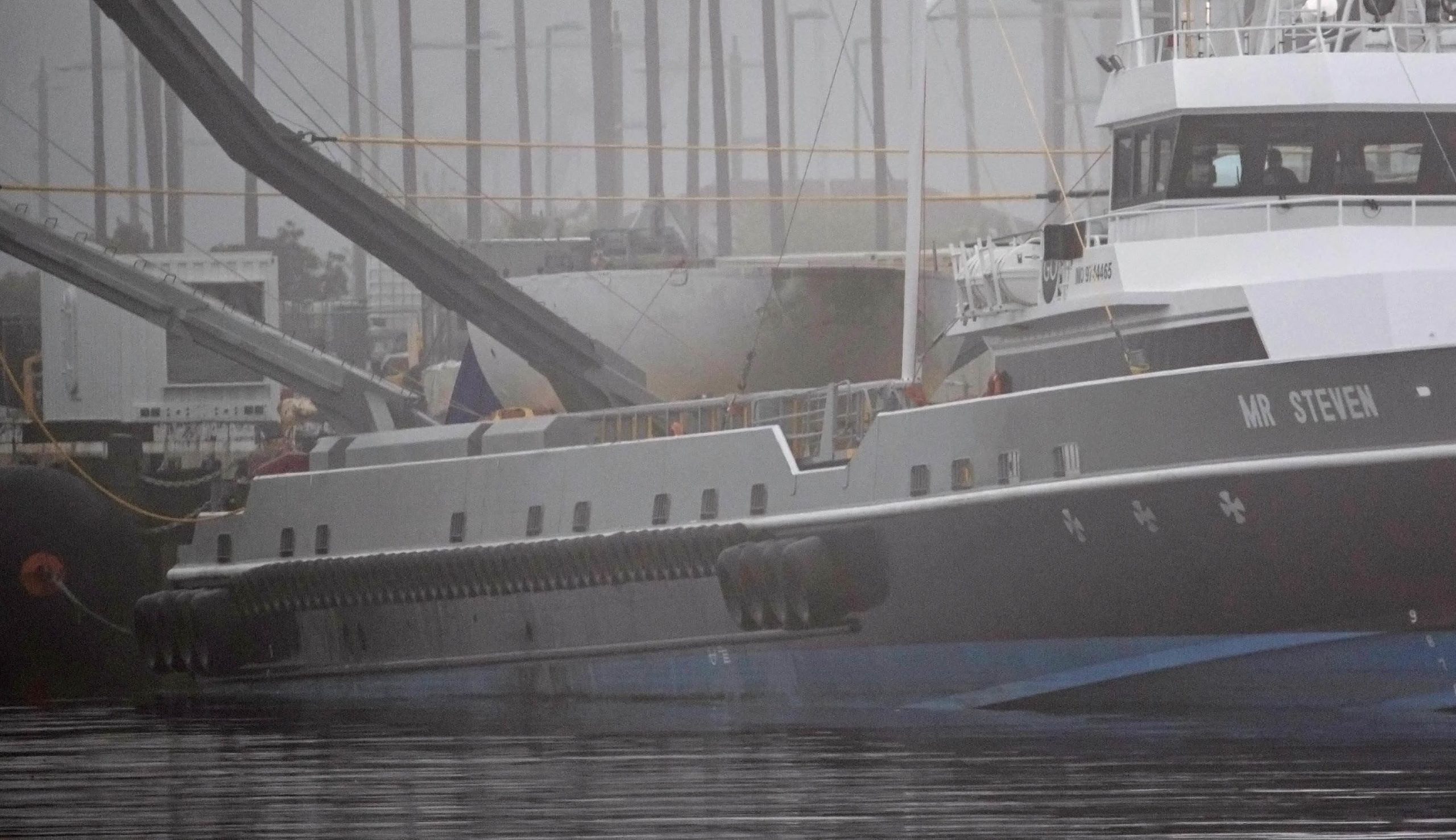
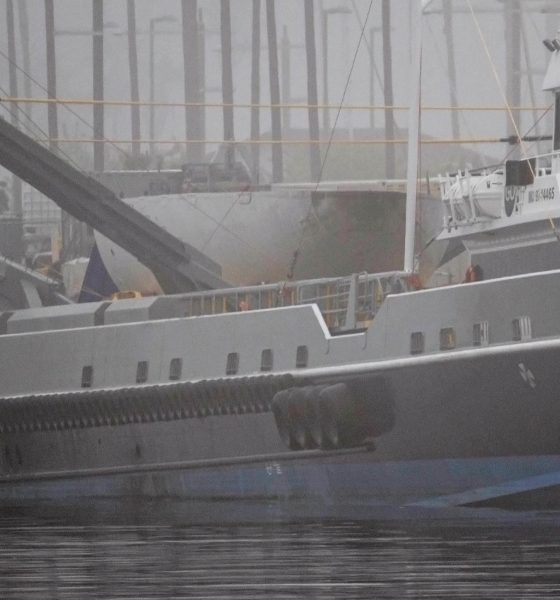
News
SpaceX returns intact fairing half on clawboat in post-launch surprise
Despite a statement from SpaceX CEO Elon Musk that the Iridium-5 mission’s fairing recovery attempt had failed due to a twisted parafoil, Teslarati captured photos of clawboat Mr Steven arriving in the Port of San Pedro early Saturday morning with an apparently intact fairing half.
Not to be confused with the first successfully recovered fairing that returned to land in late February, this half is undoubtedly fresh from Iridium-5’s Friday morning launch. The $2.5 million, carbon composite aluminum fairing half recovered during SpaceX’s PAZ mission on February 22 is currently being stored and scrapped at SpaceX’s brand new port real estate – Berth 240, or the same location that was selected as the probable location for SpaceX’s first BFR manufacturing facility.
- The Iridium-5 half, however, is not believed to have suffered any significant structural damage during recovery ops. (Pauline Acalin)
- Falcon 9 1041 rises above a sea of fog for one last mission to orbit. Half of its fairing made a surprise appearance in port on Saturday. (Pauline Acalin)
- An unmistakable Falcon 9 fairing half seen aboard the vessel Mr Steven on Saturday morning. (Pauline Acalin)
- Teslarati photographer Pauline Acalin made her way to a foggy Port of San Pedro early Saturday morning to welcome Mr Steven home. (Pauline Acalin)
Compared to Musk’s previous comments during the first intact fairing recovery in late February, it would seem that Iridium-5’s fairing was all but doomed when it “impacted [the] water at high speed,” and the majority of fans appeared to have concluded as much. Following PAZ, Musk tweeted that the Mr Steven had “missed by a few hundred meters, but fairing landed intact in water” – as an incredibly optimized and lightweight structure, a fairing half would likely have to land very gently to avoid breaking into pieces. That Mr Steven’s crew was able to bring the Iridium-5 half aboard all but guarantees that it was floating intact on the ocean surface after touching down.
GPS guided parafoil twisted, so fairing impacted water at high speed. Air wake from fairing messing w parafoil steering. Doing helo drop tests in next few weeks to solve.
— Elon Musk (@elonmusk) March 30, 2018
This does not necessarily contradict Musk’s diagnosis of a twisted parafoil, assuming he was referring to the lines that connect the fairing to the foil – paragliders frequently suffer tangles and twists in their lines, an event that typically warps the parafoil’s structure, thus lowering the amount of lift it can produce as a wing. This is an inevitable risk of what is basically a self-inflating wing, and failures of this sort are known to kill or injure paragliders at low altitudes and can also lead to uncontrolled spinning (although that is very unlikely to occur with a 1000kg payload).
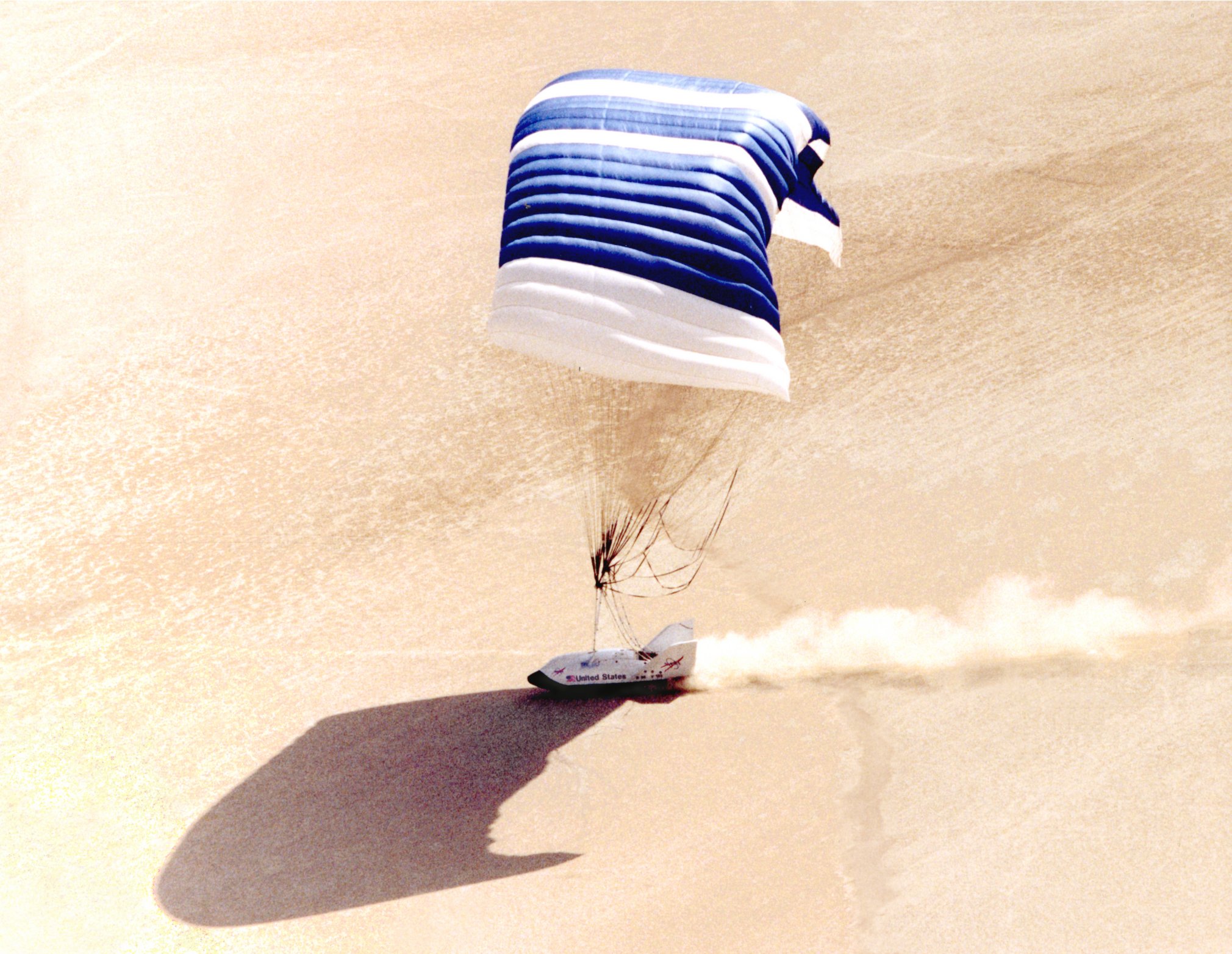
A NASA experiment in the late 90s examined the use of a parafoil to enable gentle, guided landings of an orbital escape pod – the experiment was quite successful. (NASA)
Ultimately, GPS-guided parafoils have been done fairly successfully and many times over during the past two or so decades. For the most part,the problems preventing SpaceX from recovering fairings in Mr Steven’s net have been almost entirely solved: the fact that two fairing halves have been recovered intact after their last two Western launches confirm as much. SpaceX engineers have somehow found a way to enable a highly flexible, lightweight, and aerodynamically awkward lifting body to survive a journey from heights of 110+ km and speeds of more than 2250 meters per second.
SpaceX’s fairings may look unassuming dressed in their subtle soot and simple curved lines, but – as SpaceX has intoned in the past – if landing massive Falcon 9 boosters after launch is akin to “launching a pencil over the Empire State building and having it land on a shoebox on the other side…during a wind storm,” recovering the relatively minuscule and light fairings can be fairly compared to launching a paper bowl over two stacked Empire State Buildings in a tornado and catching it with one hand behind your back on the opposite side – all without ripping, folding, or denting it.
- It may look unassuming, but that fairing half could swallow an entire school bus and by all means should not be in one piece. (Fairing from PAZ, photo by Elon Musk)
- Falcon 9 B1041.2 seen before launching Iridium-5. (Pauline Acalin)
SpaceX is 99% of the way to successful and routine fairing recovery and reuse and the final 1% is all about testing and subtle refinement. Future fairing recovery attempts may even be streamed in real time on SpaceX’s webcasts, according to Musk.
Follow us for live updates, behind-the-scenes sneak peeks, and a sea of beautiful photos from our East and West coast photographers.
Teslarati – Instagram – Twitter
Tom Cross – Twitter
Pauline Acalin – Twitter
Eric Ralph – Twitter

News
Tesla Model Y demand in China is through the roof, new delivery dates show
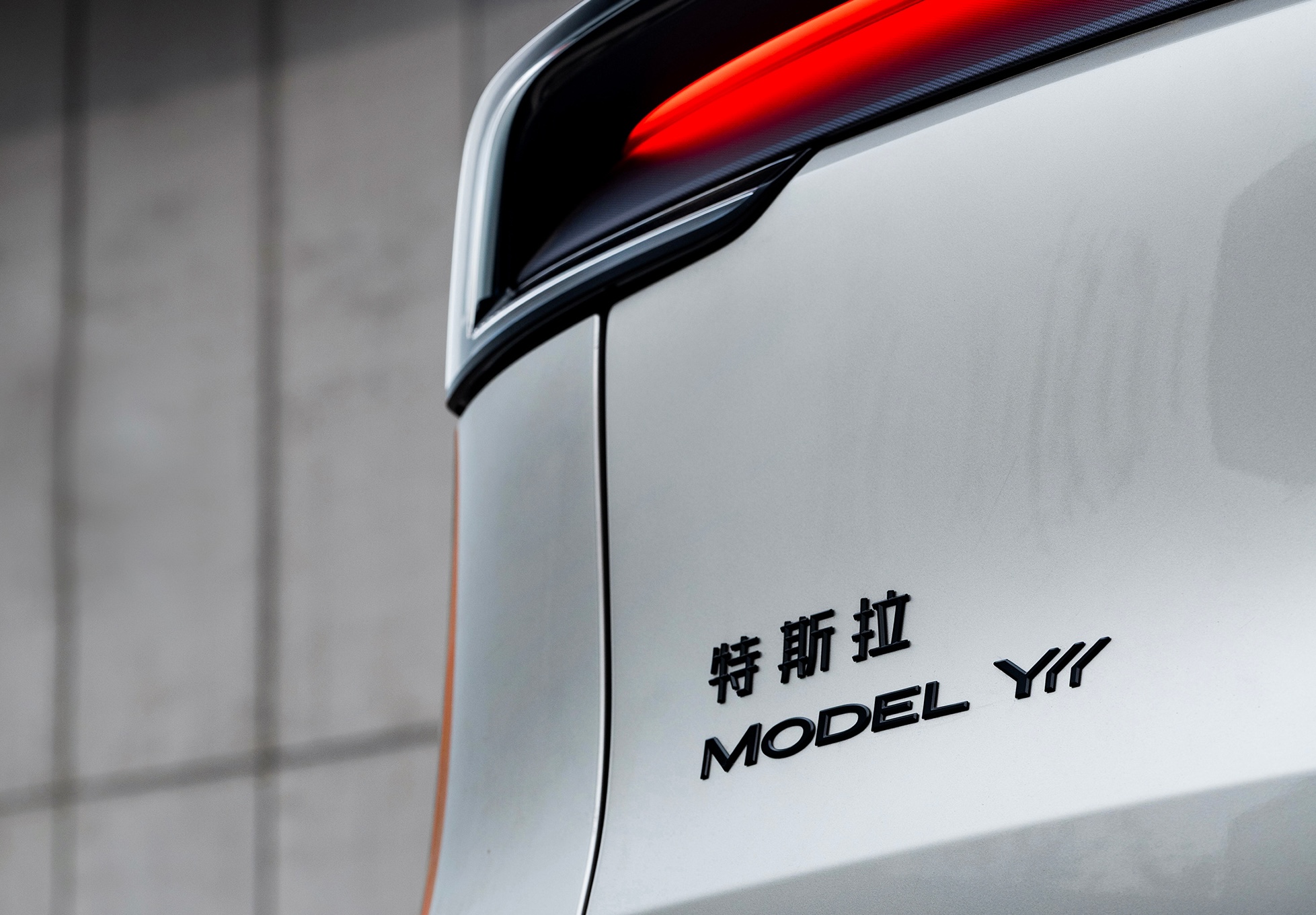
Tesla Model Y demand in China is through the roof, and new delivery dates show the company has already sold out its allocation of the all-electric crossover for 2025.
The Model Y has been the most popular vehicle in the world in both of the last two years, outpacing incredibly popular vehicles like the Toyota RAV 4. In China, the EV market is substantially more saturated, with more competitors than in any other market.
However, Tesla has been kind to the Chinese market, as it has launched trim levels for the Model Y in the country that are not available anywhere else. Demand has been strong for the Model Y in China; it ranks in the top 5 of all EVs in the country, trailing the BYD Seagull, Wuling Hongguang Mini EV, and the Geely Galaxy Xingyuan.
The other three models ahead of the Model Y are priced substantially lower.
Tesla is still dealing with strong demand for the Model Y, and the company is now pushing delivery dates to early 2026, meaning the vehicle is sold out for the year:
NEWS: New orders for all four Tesla Model Y trims in China are now officially sold out for 2025, as the factory’s remaining production capacity for the year has been fully allocated.
Estimated delivery dates for new orders now show January-February 2026. pic.twitter.com/Dfnu7yY58N
— Sawyer Merritt (@SawyerMerritt) December 1, 2025
Tesla experienced a 9.9 percent year-over-year rise in its China-made EV sales for November, meaning there is some serious potential for the automaker moving into next year despite increased competition.
There have been a lot of questions surrounding how Tesla would perform globally with more competition, but it seems to have a good grasp of various markets because of its vehicles, its charging infrastructure, and its Full Self-Driving (FSD) suite, which has been expanding to more countries as of late.
Tesla Model Y is still China’s best-selling premium EV through October
Tesla holds a dominating lead in the United States with EV registrations, and performs incredibly well in several European countries.
With demand in China looking strong, it will be interesting to see how the company ends the year in terms of global deliveries.
News
Tesla Europe rolls out FSD ride-alongs in the Netherlands’ holiday campaign
The festive event series comes amid Tesla’s ongoing push for regulatory approval of FSD across Europe.
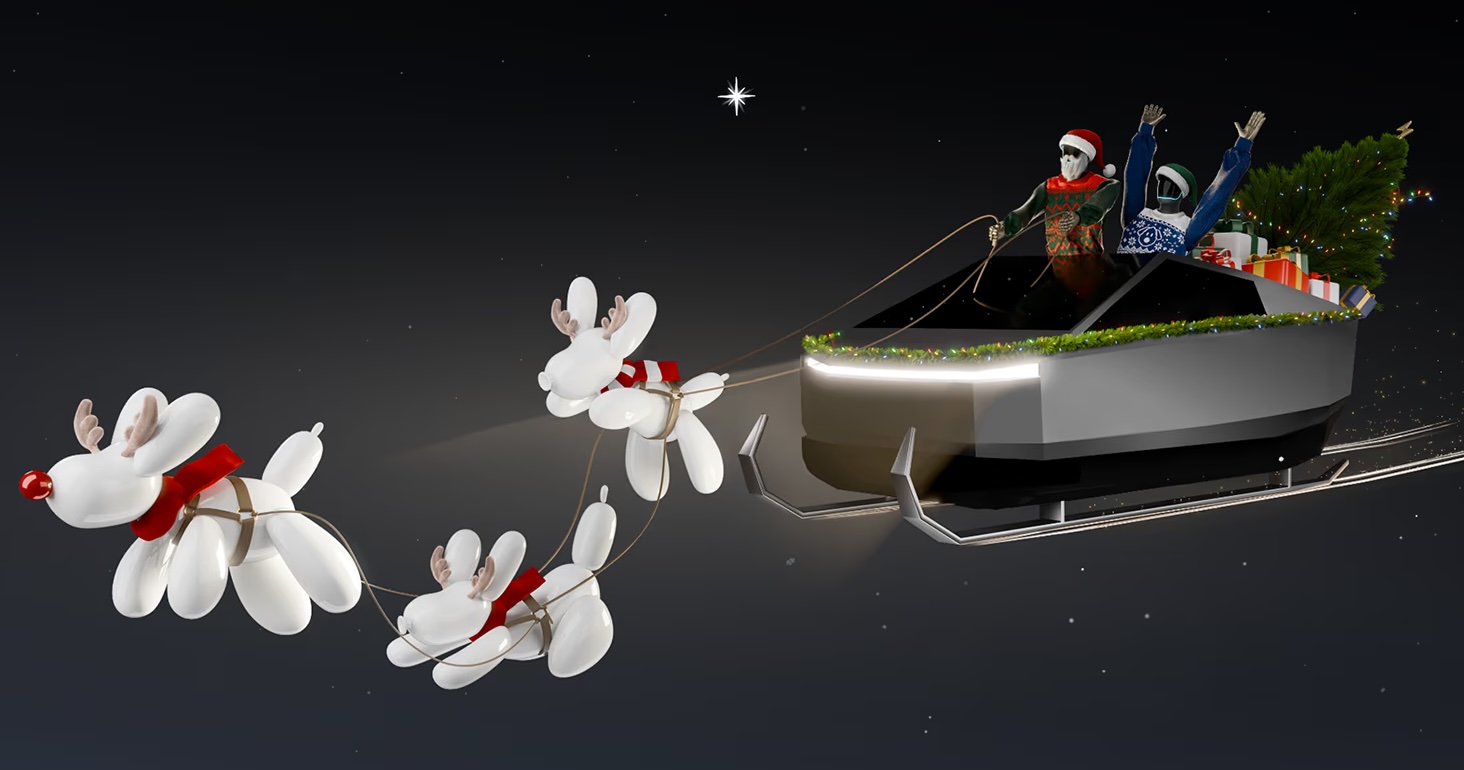
Tesla Europe has announced that its “Future Holidays” campaign will feature Full Self-Driving (Supervised) ride-along experiences in the Netherlands.
The festive event series comes amid Tesla’s ongoing push for regulatory approval of FSD across Europe.
The Holiday program was announced by Tesla Europe & Middle East in a post on X. “Come get in the spirit with us. Featuring Caraoke, FSD Supervised ride-along experiences, holiday light shows with our S3XY lineup & more,” the company wrote in its post on X.
Per the program’s official website, fun activities will include Caraoke sessions and light shows with the S3XY vehicle lineup. It appears that Optimus will also be making an appearance at the events. Tesla even noted that the humanoid robot will be in “full party spirit,” so things might indeed be quite fun.
“This season, we’re introducing you to the fun of the future. Register for our holiday events to meet our robots, see if you can spot the Bot to win prizes, and check out our selection of exclusive merchandise and limited-edition gifts. Discover Tesla activities near you and discover what makes the future so festive,” Tesla wrote on its official website.
This announcement aligns with Tesla’s accelerating FSD efforts in Europe, where supervised ride-alongs could help demonstrate the tech to regulators and customers. The Netherlands, with its urban traffic and progressive EV policies, could serve as an ideal and valuable testing ground for FSD.
Tesla is currently hard at work pushing for the rollout of FSD to several European countries. Tesla has received approval to operate 19 FSD test vehicles on Spain’s roads, though this number could increase as the program develops. As per the Dirección General de Tráfico (DGT), Tesla would be able to operate its FSD fleet on any national route across Spain. Recent job openings also hint at Tesla starting FSD tests in Austria. Apart from this, the company is also holding FSD demonstrations in Germany, France, and Italy.
News
Tesla sees sharp November rebound in China as Model Y demand surges
New data from the China Passenger Car Association (CPCA) shows a 9.95% year-on-year increase and a 40.98% jump month-over-month.
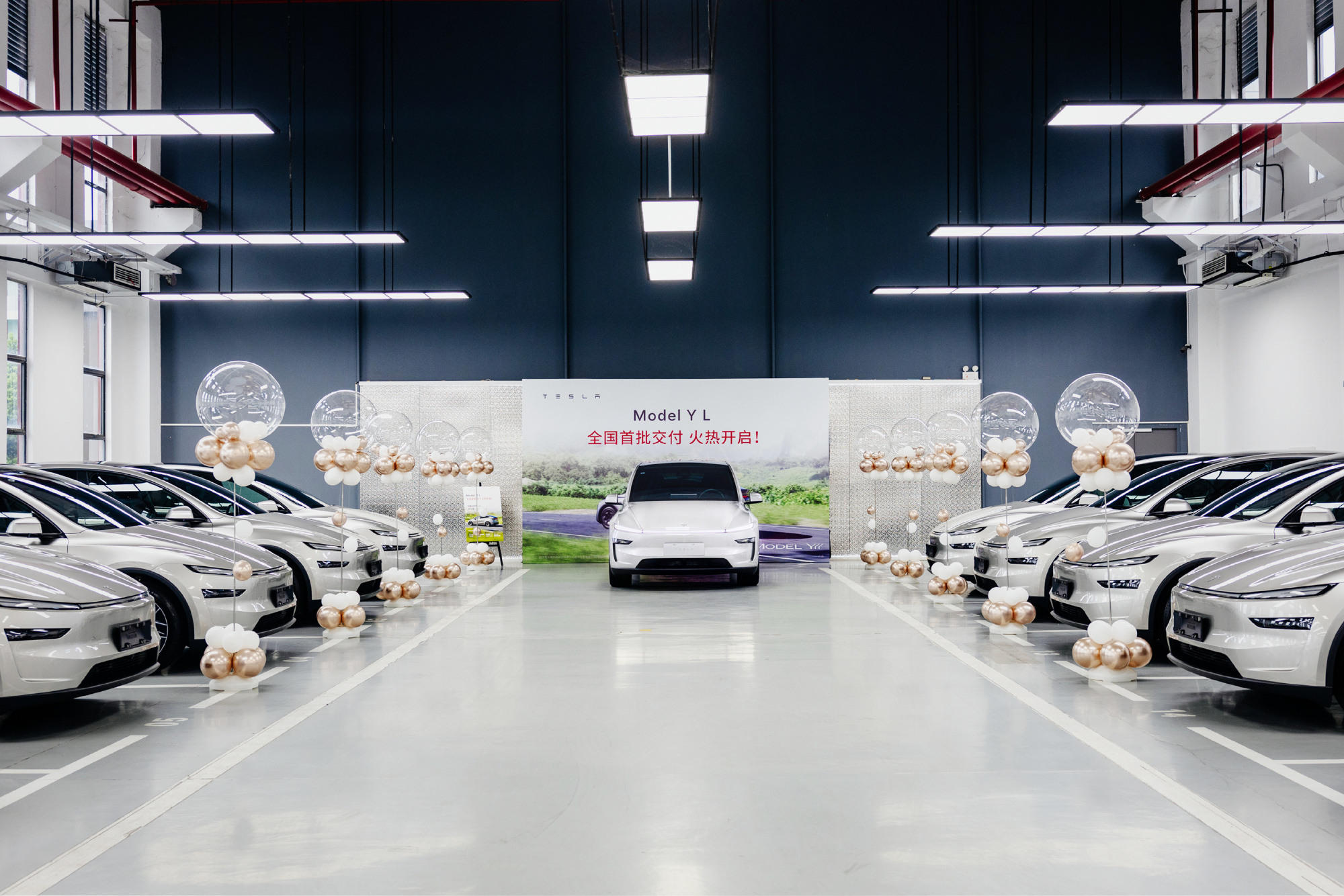
Tesla’s sales momentum in China strengthened in November, with wholesale volumes rising to 86,700 units, reversing a slowdown seen in October.
New data from the China Passenger Car Association (CPCA) shows a 9.95% year-on-year increase and a 40.98% jump month-over-month. This was partly driven by tightened delivery windows, targeted marketing, and buyers moving to secure vehicles before changes to national purchase tax incentives take effect.
Tesla’s November rebound coincided with a noticeable spike in Model Y interest across China. Delivery wait times extended multiple times over the month, jumping from an initial 2–5 weeks to estimated handovers in January and February 2026 for most five-seat variants. Only the six-seat Model Y L kept its 4–8 week estimated delivery timeframe.
The company amplified these delivery updates across its Chinese social media channels, urging buyers to lock in orders early to secure 2025 delivery slots and preserve eligibility for current purchase tax incentives, as noted in a CNEV Post report. Tesla also highlighted that new inventory-built Model Y units were available for customers seeking guaranteed handovers before December 31.
This combination of urgency marketing and genuine supply-demand pressure seemed to have helped boost November’s volumes, stabilizing what had been a year marked by several months of year-over-year declines.
For the January–November period, Tesla China recorded 754,561 wholesale units, an 8.30% decline compared to the same period last year. The company’s Shanghai Gigafactory continues to operate as both a domestic production base and a major global export hub, building the Model 3 and Model Y for markets across Asia, Europe, and the Middle East, among other territories.
